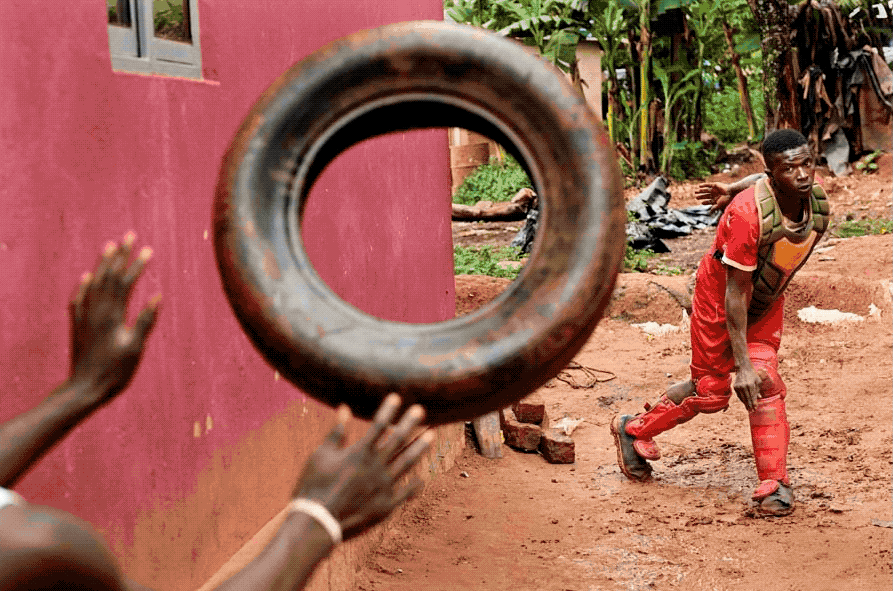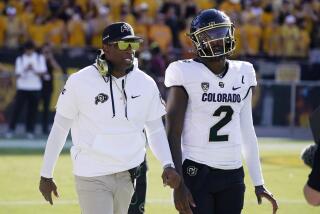When Role Models Set a Bad Example : How can a kid look up to an athlete whoâs a lawbreaker?
The spotlight bathes our college and professional athletes but not all are cleansed. Sometimes the light reaches into those dark corners where sports and criminal violence coalesce. Kill the umpire, the crowds once cried. Beat the wife is more like it nowadays.
In âCrime & Sports â95, a Times Special Report,â the case was made that news of athletesâ arrests increasingly has received prominent display in the media. Researchers put the number of American and Canadian athletes and team officials who ran afoul of the criminal justice system in 1995 at 345. The charges ranged from rape and battery to drug possession and drunkenness. A reflection of American society, yes. But weâre talking about men and women who are role models, whether they like it or not. And these athletes know the law, almost to the letter. Their coaches and advisors drill it into them, for the teamâs sake, for the program and for the coachâs own fortunes in keeping the best players on the field.
THE BAD OLD BOYS: Violence in the sports world is not new. Many an old hero was also an old bully. Baseballâs Billy Martin and Ty Cobb are sad examples. But a cozy relationship between athletes and sportswriters kept the worst offenses out of the newspapers. The TV camera and the post-Watergate investigative bent of journalism have changed that. There was no cover-up last summer when the 7-year-old son of Minnesota Viking quarterback Warren Moon dialed 911 and said his father was beating his mother. Moon publicly apologized and underwent counseling. His wife asked that the charges be dropped. But in this day his alleged crime could not be swept away. He faces trial in February. And rightly so. Itâs time to blow the whistle off the field too.
Probing the causes of violence among athletes, the Times report came up with some expected answers and some surprises. Privileged treatment has always been a stumbling block for young men who play games, in college or for the pros. Their heads can get larger than their helmets. Normal rules of behavior seem to melt before them. Big money exaggerates the problem. Booze is as common to athletics as leather, and drugs are a growing problem. But why do privilege, adulation and a roll of greenbacks lead to violence?
âROID RAGEâ: A psychiatrist who worked with the University of Nebraska football team for 10 years says some top athletes suffer manic depression, which can take aggressive forms. Other athletes may be subject to âroid rage,â resulting from the use of steroids in body building. Trying to counsel a violent athlete is âlike taking a T. Rex to charm school,â the psychiatrist told The Times. He recommends medication in some cases.
Says California Atty. Gen. Dan Lungren: âYou have [more] athletes arrested for what I consider serious crimes .J.J. particularly against women. [The situation] is worse now than ever before.â Statistical studies tend to support him, although investigations into the patterns of spousal abuse are fairly recent. A study of sexual assault at 30 universities showed that male athletes, just 3.3% of the student bodies, were accused in 19% of the crimes.
Old-timers like Tony Gwynn, the San Diego Padresâ All-Star player, shake their heads over the behavior of some young athletes. âSome will listen and with others you are just spinning your wheels,â he said. âThe bottom line is that just because you are good at baseball or any other sport, doesnât mean you are above the law. For some of these guys it just doesnât sink in.â So who can help make it sink in? The fans, yes. And any coach who can see beyond the current season. And prosecutors. Itâs a shame that more and more it has come to the last of these three.
More to Read
Go beyond the scoreboard
Get the latest on L.A.'s teams in the daily Sports Report newsletter.
You may occasionally receive promotional content from the Los Angeles Times.










